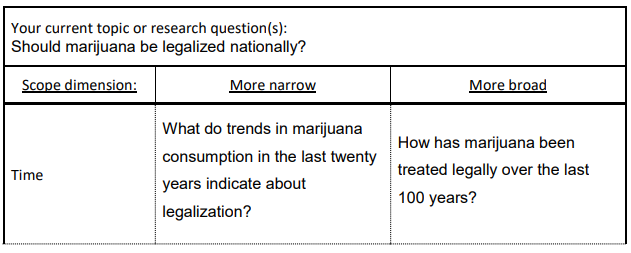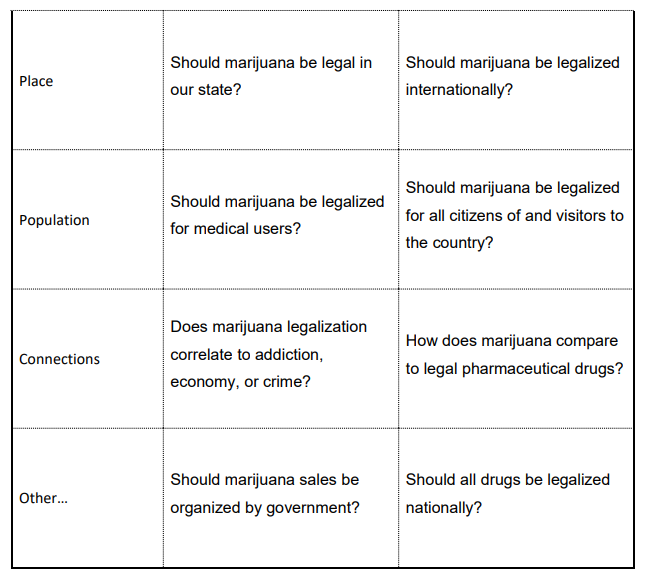5.2.3: Activites
- Last updated
- Save as PDF
- Page ID
- 109854
Activities
Idea Generation: Curiosity Catalogue103 and Collaborative Inquiry
This exercise encourages you to collaborate with other classmates to develop a topic, working questions, a path of inquiry, and a baseline of communal knowledge. You should compete Part One independently, then gather with a small group of two or three other students for Part Two, and a different small group of two or three other students for Part Three: Small Group. (If you are working on this exercise as a full class, complete Part One, Part Two, and Part Three: Gallery Walk.) Before you get started, divide three large sheets of paper (11x17 is best) into columns like this:
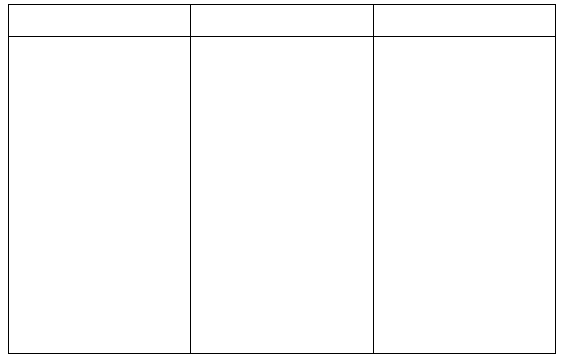
Part One
Create a catalogue of topics you are personally curious about- things that you want to learn more about. These don't have to be revolutionary things right away; it's more important that they're meaningful to you. First, choose three of the following broad topic headings:
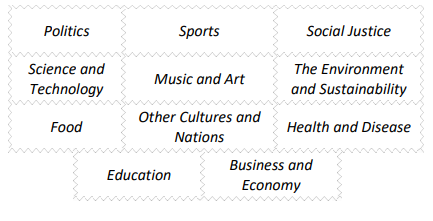
On your first sheet of three-column paper, write those three topic headings.
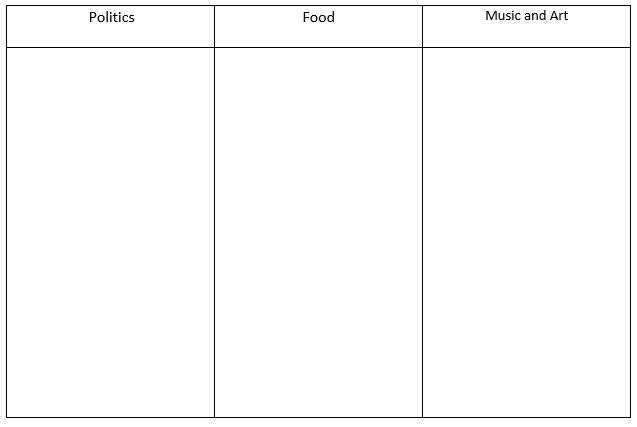
Next, underneath each topic heading, write bulleted lists of as many subtopics or related ideas that come to mind that interest you. (Try not to censor yourself here- the idea is to generate a large number of bullet points. To some extent, this is an exercise in free association: what are the first things that come to mind when you think of each topic?) Spend ten to fifteen minutes on your lists. Then, take a five-minute break away from your lists and clear your head; return to your lists for three more minutes to make any additions that you didn't think of at first.
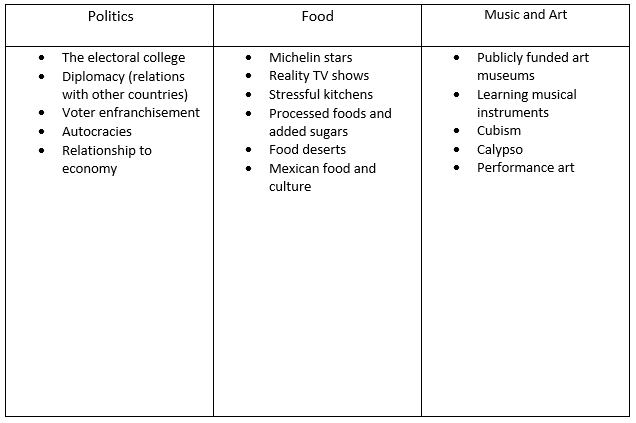
Part Two
Begin to develop a working knowledge by collaborating with classmates to consider the topic from several persepctives beyond your own.
Write your three favorite list items from Part One in the headings for your second piece of three-column paper. Sit in a circle with your groupmates; each student should pass their three-column paper one position clockwise. For five minutes, each student will free-write what they already know about each topic using prose, lists, or illustrations. Then, rotate your papers another step- repeat until you have your original sheet of paper back.
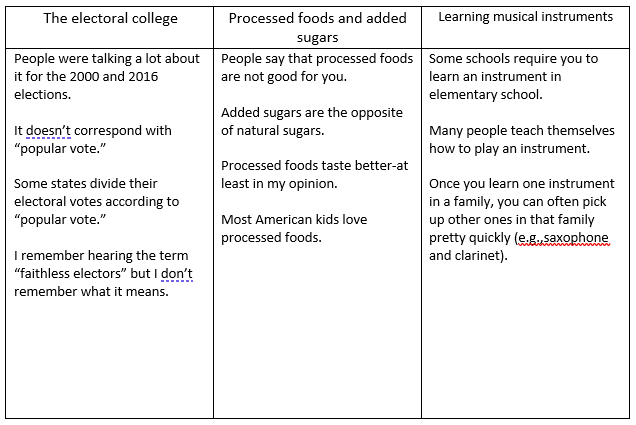
Review the knowledge your groupmates compiled on your sheet. Have they offered anything that surprises you- stuff you didn't already, conflicting perspectives, or connections to other ideas or topics?
Part Three: Small Group
Begin to develop working and research questions by collaborating with your classmates to explore different curiosities. (This part of the exercise is designed for a small group of three or four total students, including you, different from the group in Part Two. If you are completing this part of the exercise with your whole class, skip to Part Three: Gallery Walk.)
Write your three favorite list items from Part One, potentially modified by insight from Part Two, in the headings for your third piece of three-column paper.
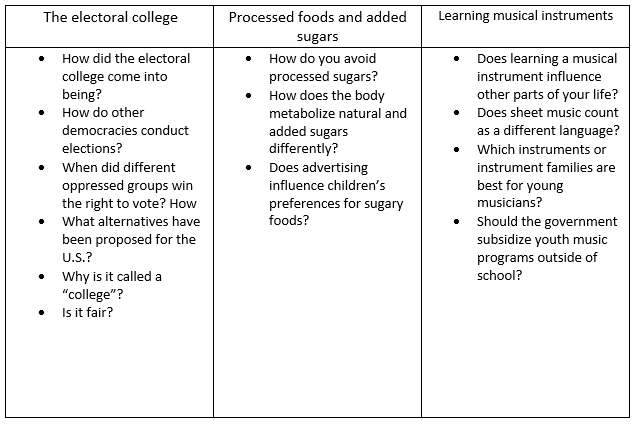
Sit in a circle with your groupmates; each student should pass their three-column paper one position clockwise. For five minutes, each student will free-write questions about each topic. No question is too big or small, too simple or complex. Try to generate as many questions as you possibly can. Then, rotate your papers another step- repeat until you have your original sheet of paper back.
Review the questions your groupmates compiled on your sheet. Have they offered anything that surprises you- issues you haven't thought of, relationships between questions, recurring themes or patterns of interest, or foci that might yield interesting answers?
Part Three: Gallery Walk
Begin to develop working and research questions by collaborating with your classmates to explore different curiosities. (This part of the exercise is designed for an entire class of students of about twenty to twenty-five students, including you. If you are completing this part of the exercise a small group of three to four total students, including you, return to Part Three: Small Group.)
Write your three favorite list items from Part One, potentially modified by insights from Part Two, in the headings for your third piece of three-column paper. Every student should tape their papers to the classroom wall, just below eye-level, such that it forms a circular shape around the perimeter of the room. Each student in the class should in front of their paper, then rotate one position clockwise. At each new page, you will have two minutes to review the headings and free-writing questions about each topic. No question is too big or small, too simple or complex. Try to generate as many questions as you possibly can. Then, rotate through clockwise until you've returned to your original position.
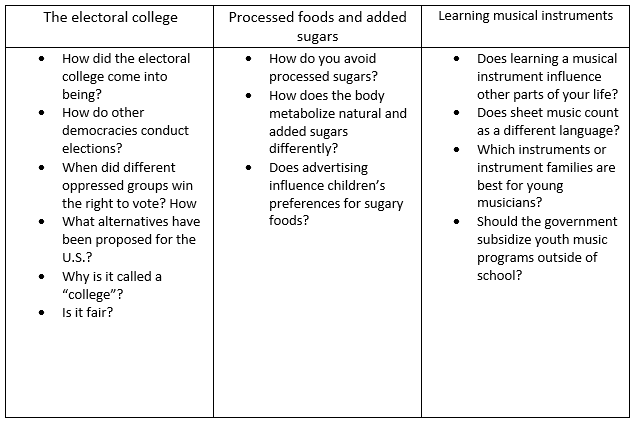
Review the questions your classmates compiled on your sheet. Have they offered anything that surprises you- issues you haven't though of, relationships between questions, recurring themes or patterns of interest, or foci that might yield interesting answers?
After completing all three parts of this exercise, try to articulate a viable and interesting research question that speaks to your curiosity. Make sure its scope is appropriate to your rhetorical situation; you can use the exercise "Focus: Expanding and Contracting Scope" later in this chapter to help expand or narrow your scope.
If you're still struggling to find a topic, try some of other idea generation activities that follow this, or check in with your school's Writing Center, your teacher, or your peers.
Idea Generation: Mind-Mapping
By organizing and exploring your current knowledge, you might find an area of interest for your research project. A mind-map, also known as a "web" or "cluster," is a graphic representation of your thought processes. Since this forms allows for digressions, free association, and wandering, it allows for organic thinking and knowledge-building.
Start out by putting a general subject area in the middle of a blank piece of paper in a circle- for the example below, I started with "education." (If you don't have any immediate ideas, try Part One of the Curiosity Catalogue exercise above.) Then, branch out from this general subject to more specific or connected subjects. Because this is a pre-writing activity, try to generate as many associations as you can: don't worry about being right or wrong, or using standardized grammar and spelling. Your goal is to create as many potential topics as possible.

Once you've focused your mind-map, review the idea or clusters of ideas that seem to demand your attention. Did any of your bubbles or connections surprise you? Do you see any patterns? Which were most engaging to meditate on? From these topics and subtopics, try to articulate a viable and interesting research question that speaks to your curiosity. Make sure its scope is appropriate to your rhetorical situation; you can use the exercise "Focus: Expanding and Contracting Scope" later in this chapter to help expand or narrow your scope.
Idea Generation: Internet Stumbling
In addition to its status as an ever-expanding repository of knowledge, and in addition to its contributions to global human connection, the Internet is also an exceptional free association machine. Through the magic of hyperlinks and social media, random chance can set us in the right direction to develop a research topic. Spend fifteen to twenty minutes clicking around on the Internet, using one of the following media for guidance, and jot down every potential topic that piques your interest.
- Wikipedia: Go to the Wikipedia homepage and check out the "featured article" of the day, or choose "Random Article" from the sidebar on the far left. Click any of the hyperlinks in the article to redirect to a different page. Bounce from article to article, keeping track of the titles of pages and sections catch your eye.
- StumbleUpon: Set up a free account from this interest randomizer. You can customize what kinds of pages, topics, and media you want to see.
- An Instagram, Facebook, reddit, or Twitter feed: Flow through one or more social media feeds, using links, geotags, user handles, and hashtags to encounter a variety of posts.
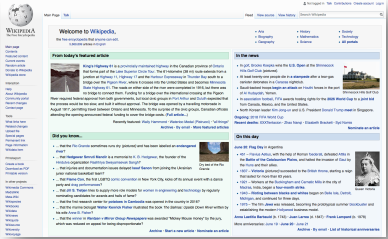
After stumbling, review the list you've made of potentially interesting topics. Are you already familiar with any of them? Which surprised you? Are there any relationships or intersections worth exploring further? From these topics and subtopics, try to articulate a viable and interesting research question that speaks to your curiosity. Make sure its scope is appropriate to your rhetorical situation; you can use the exercise "Focus: Expanding and Contracting Scope" later in this chapter to help expand or narrow your scope.
Focus: Expanding and Contracting Scope
At this point, you have hopefully identified some topic or path of inquiry for your research project. In order to experiment with scope, try complicating your research question(s) along the different dimensions in the following table. A completed table is included as an example after the blank one.
Exercise


Example Model
